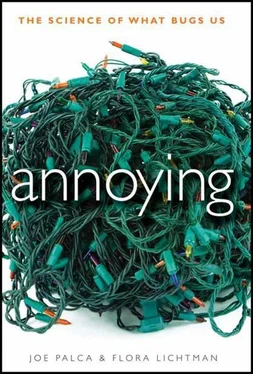If she tests a hundred people, she can then compare men’s happiness scores with women’s happiness scores because they are all anchored by the sunlight standard. Or she can measure whether obese people are happier than lean people. The comparisons become meaningful because of the absolute standard they’re measured against.
• • •
Another type of scaling method that Bartoshuk is experimenting with involves training the subjects in her studies to compare food taste sensations with the loudness of sounds. She told them, “If you give a sound a 9 on a scale of 0 to 9, and you give a food a 9, it means the intensity of liking the food is equal to the intensity of the loudness.” Similarly, if you were indifferent to a food, this would be linked to a barely audible sound.
At first, many subjects think that comparing loudness with taste is daft, but Bartoshuk has an easy way to show them that at least in principle, it’s possible. She gives them a small sip of water that has a barely detectable amount of salt in it, and then she plays them a sound so loud it makes their teeth rattle. “And I ask, ‘Do they match?’ And they say, ‘Of course, they don’t.’ Then I give them a sip of extremely salty water and play an extremely soft tone, and I ask, ‘Do they match?’ And they say, ‘No.’ So, they understand that you can match these up.”
Sounds can be measured with well-calibrated instruments. If you can get people to anchor their likeness scale to a sound scale, where 1 is the softest sound they can possibly hear and 10 is the loudest sound they can possibly stand, then you can start to say meaningful things about how a 5 on one person’s likeness scale compares with a 5 on someone else’s likeness scale.
To set up her test of annoyance, Bartoshuk piggybacked it onto another experiment she’s working on. She has teamed up with plant biologist Harry Klee to try to measure what people like about tomatoes. In particular, she wants to help Klee design a tomato variety that yields many fruits, something that farmers like, and is good tasting, something that consumers like.
In this particular case, after collecting information about age, weight, sex, and a few other demographic variables, Bartoshuk asks subjects to think of the one thing that gave them the most pleasure and assign that a score of 100. By the way, most people do not assign 100 to sex. It’s usually something more along the lines of being with a loved one or creating something special. Then she asks her subjects to give a score of minus 100 to the most unpleasant experience they’ve ever had. This might be death of a loved one, a really painful injury, or the pain of childbirth. Then she asks them to assign a score to questions such as, How much do you like your favorite food? What’s the most amused you’ve ever been? What’s the best lecture you’ve ever heard (these are largely college students)? And, What’s the best tomato you’ve ever eaten? Finally, she asks them to assign a score to the most annoyed they’ve ever been and the most angry they’ve ever been.
The preliminary results were gratifying. “It’s clear that the distributions of ratings of annoyance and anger are quite different,” says Bartoshuk. “That is probably enough to argue that annoyance is not a subset of anger.”
In general, women rated the most annoyed they’d ever been as less intense than men’s ratings. Perhaps more surprising was the relationship between body mass index and annoyance. Bartoshuk found that overweight people tended to be more annoyed than normal or underweight people were, although it will require more study participants to be certain that this is a real difference.
Perhaps most interesting for Bartoshuk: supertasters have more intense maximum anger and annoyance. This suggests that supertasters are also superfeelers. This last point could become extremely important. Bartoshuk is toying with the notion that the same absolute standard that determines whether someone is a supertaster could be used to compare people’s experience of how annoying something is.
Here’s how it would work. You can determine with virtual certainty whether people are supertasters by counting how many fungiform papillae are present on their tongues. These papillae contain our taste buds, structures that turn the chemical constituents of food into signals that our nerves can carry to our brains. The more you have, the more sensitive you are to tastes. Because the number of fungiform papillae is measurable, just as the number of photons coming from the sun is measurable, Bartoshuk hopes she can prove that the papillae count will be her Rosetta stone for scaling sensations such as annoyance. Ultimately, she wants scientists to get out of the annoying habit of using scales that can’t be compared.
While Bartoshuk is trying to understand how intensely people feel annoyance, other researchers are trying to figure what provokes the most intensely annoying feelings—and why.
3. Fingernails on a Chalkboard
Randolph Blake is a vision specialist. He has studied the intersection of psychology and sight for most of his career. Now a professor of psychology at Vanderbilt University, he’s interested in figuring out which parts of the brain process various kinds of visual information.
Back in 1986, Blake was working on the infant science of image processing. Forget about automatic red-eye reduction; the world hadn’t even been introduced to Photoshop yet (it was released in 1990). Manipulating a digital image meant writing your own computer program to do it. To test his programming approach, Blake started with sound because, like light, it’s made up of complex waveforms that vary in frequency and amplitude—but it’s simpler and easier to analyze.
Blake chose to analyze annoying sounds. He was curious whether certain frequencies are intrinsically annoying to us. Almost any sound can be annoying if it is blasted at an earsplitting level. Certain sounds, however—even at low levels—have a reputation for provoking instant annoyance. Perhaps most infamously, there is the sound of fingernails on a chalkboard. Blake wondered, What makes this sound unpleasant to so many people?
Step one: Create a device that consistently produces the fingernails-on-a-chalkboard sound and confirm that people find the noise exceptionally annoying. “I went to an Ace hardware store and got a three-pronged garden tool and a piece of slate,” Blake says. It turns that out when you slowly scrape the True Value Pacemaker cultivator over a slate surface, the sound produced is “disturbingly similar to the sound of fingernails scratching across a chalkboard,” Blake and his colleagues wrote in the journal Perception and Psychophysics . {12} 12 1. Lynn Halpern, Randolph Blake, and James Hillenbrand, “Psychoacoustics of a Chilling Sound,” Perception and Psychophysics (1986): 77–80.
The researchers recorded the synthetic fingernail sound in the auditory labs at Northwestern University, the institution where Blake worked at the time, with a Teac A-3300S reel-to-reel tape recorder (it’s 1986, remember) and an AKG Acoustics CK 4 microphone. They also catalogued a few other irritating noises. They rubbed two pieces of Styrofoam together. They shook metal parts. They dragged a stool across the floor. They ran a blender. They opened a squeaky metal drawer, over and over again. “I have to admit, you can immunize yourself,” says Blake. “If you listened to these sounds over and over—as I had to do while I was preparing for this study—they never lost their aversive quality, but the valence of the experience was toned down a little bit.” Total immunity wasn’t possible. “Even to this day,” he says, “if you mention fingernails scraping on a chalkboard, I get chills just thinking about it.”
Читать дальше












